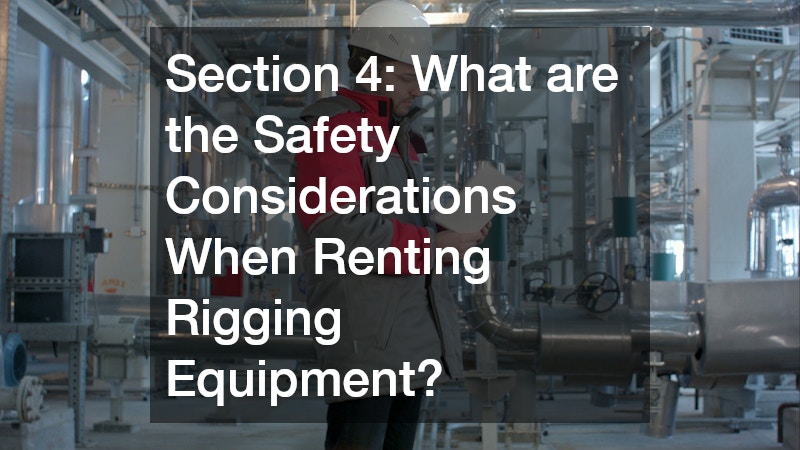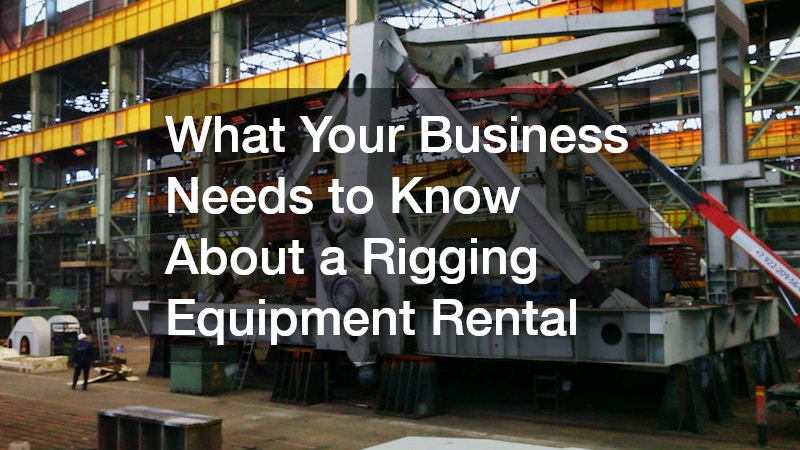Rigging equipment rental is a crucial consideration for businesses operating in construction, manufacturing, and various industries requiring heavy lifting. By opting for rental, companies can gain significant advantages while maintaining operational efficiency and flexibility.
This practice is not only cost-effective but also offers the benefit of accessing modern technology without the hefty initial financial outlay. Additionally, rental agreements often include maintenance and servicing options, alleviating these responsibilities from the business.
Understanding the nuances of rigging equipment rental, from cost implications to safety considerations, can empower businesses to make informed decisions. This article aims to provide a comprehensive guide on the subject, exploring the benefits and best practices associated with renting rigging equipment.
Section 1: Why Rent Rigging Equipment?
Cost-Effectiveness and Financial Benefits
Renting rigging equipment reduces capital expenditure significantly, allowing companies to allocate resources to other critical areas. Instead of tying up capital in expensive equipment, businesses can preserve cash flow for other investments.
Maintenance and wear-and-tear costs are absorbed by the rental company, adding further financial relief to the renting business. This reduction in overhead can lead to greater operational efficiency and competitive advantage in the market.
Moreover, rentals can be accounted for as operational expenses, potentially offering tax benefits. This financial flexibility is particularly favorable for short-term or project-based operations where long-term ownership of equipment isn’t justified.
Flexibility and Access to Latest Technology
Renting offers businesses access to the latest technology in rigging equipment without the need for constant upgrades. As the industry evolves, staying updated with the latest innovations can lead to improved productivity and safety.
Equipment rentals allow companies to scale their operations swiftly according to project demands. This scalability ensures that businesses have the right tools precisely when needed, enhancing project timelines and outcomes.
In ever-changing industries, utilizing cutting-edge technologies via rental agreements can also improve a company’s reputation for innovation and efficiency. The flexibility provided by rentals can make a significant difference in both strategic long-term planning and immediate project execution.
Section 2: How to Choose the Right Rigging Equipment Rental Company?
Evaluating Provider Experience and Expertise
Assessing the experience and reliability of potential rental companies is crucial for ensuring quality service. Companies with a solid reputation and extensive industry knowledge are likely to provide better support and resources.
It’s beneficial to seek providers with a track record of working on similar projects within your industry. This alignment can result in more personalized solutions and recommendations tailored to your specific needs.
Checking for client testimonials and case studies can offer insights into the provider’s capabilities. These references can serve as valuable indicators of the service quality you can expect.
Checking Equipment Quality and Maintenance Standards
Ensuring that rented equipment meets high-quality and maintenance standards is vital for safe operation and project success. A reputable rental company will provide well-maintained equipment that adheres to industry regulations.
Regular maintenance and inspections should be documented and transparent, demonstrating the rental company’s commitment to safety and performance. Businesses should inquire about the maintenance protocols to ensure compliance with relevant standards.
High-quality equipment reduces the likelihood of operational halts due to malfunctions, contributing to improved project timelines. This reliability not only aids in maintaining productivity but also instills confidence in the rented machinery.
Section 3: What Types of Rigging Equipment are Available for Rent?
Commonly Rented Rigging Equipment
Common rigging equipment available for rent includes cranes, hoists, and winches. These tools are essential for various lifting and moving tasks, making them indispensable across multiple industries.
The range of available equipment ensures that businesses can select the most suitable options for their particular project requirements. Rentals offer the flexibility to choose specialized machinery that might not be feasible to purchase outright.
Having access to a diverse inventory of rigging tools through rentals can significantly enhance a company’s operational capacity. This adaptability ensures that companies are well-equipped to tackle a variety of project scales and scopes.
Specialized Equipment for Unique Projects
For unique or niche projects, rental companies often provide access to specialized rigging solutions. These tailored options are designed to meet specific needs where standard equipment might not suffice.
Customized equipment solutions can accommodate unusual project environments and requirements, providing the flexibility needed for complex operations. Rentals offer the chance to utilize these specialized tools without committing to outright purchase.
This approach allows businesses to stay adaptive, offering the ability to respond to unique challenges with precision. By leveraging specialized equipment, companies can enhance their project execution capabilities and operational efficiency.
Section 4: What are the Safety Considerations When Renting Rigging Equipment?
Ensuring Compliance with Regulations
Adhering to safety regulations and standards is critical when operating rented rigging equipment. Compliance ensures that operations are not only safe but also legally sound.
Rental companies should provide equipment that aligns with the latest safety standards, mitigating risk for the user. Businesses must ensure that they are familiar with all relevant regulations and guidelines pertaining to rigging equipment use.
Regular audits and inspections can help maintain high safety standards during equipment operation. Understanding these compliance requirements is crucial for protecting both personnel and assets from potential harm.
Best Practices for Safe Equipment Operation
Implementing best practices for equipment operation is essential in minimizing hazards and ensuring a safe working environment. Training staff on the correct use of rented equipment is a fundamental safety measure.
Establishing clear protocols for equipment handling, including emergency procedures, can greatly reduce accident risks. Consistent training sessions and safety drills are effective strategies in promoting a culture of safety.
By prioritizing these best practices, businesses can substantially decrease the likelihood of workplace injuries and improve overall productivity. A committed approach to safety reflects positively on a company’s operational integrity and duty of care.


